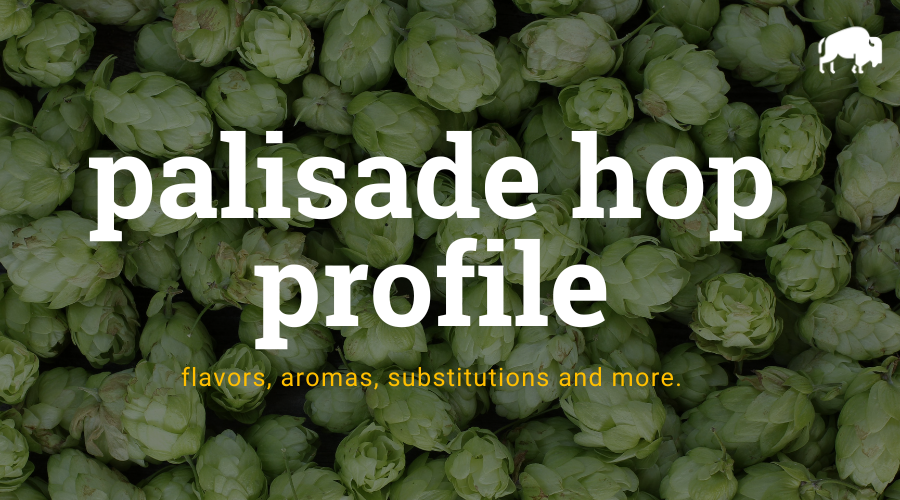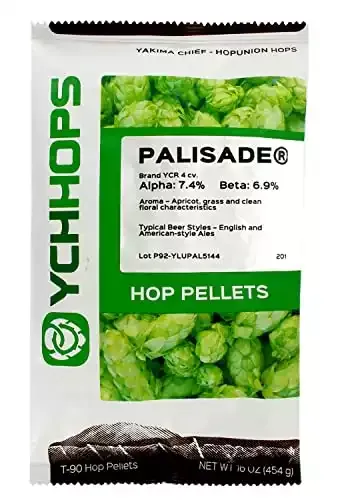
Palisade YCR 4, developed by Yakima Chief Ranches, is a high-yielding hop with Tettnang parentage, bred in the Yakima Valley. Its origins are unclear, as it may have either German or American heritage. Palisade is a highly vigorous hop that flourishes in hot, dry climates but is sensitive to downy mildew.
The aroma profile of Palisade is characterized by citrus, floral, herbal, stone fruit, and woody notes. Depending on the harvest time, its flavor can range from gentle and pleasant to aggressive and pungent. Palisade is often a blending hop, complementing Amarillo and Cascade hops in various beer styles.
Palisade hops are good to include in American Pale Ales, English Ales, American West Coast Pale Ales, India Pale Ales, and American Amber Ales.
| Usage: | Aroma |
| Country of Origin: | United States |
| Hop Growers Code: | PAL YCR 4 |
Where To Buy Palisade Hops
Palisade Flavor And Aroma
Palisade is an aroma hop that is often described to have the following aroma characteristics:

citrus

floral

grassy
Palisade Hop Oil Breakdown
Hop oils can vary from year to year and farm to farm but based on our research, here are the typical values we have seen reported. This information comes from various hop farms, The Hop Aroma Compendium, and For The Love Of Hops.
| Alpha Acid % (AA) Alpha acids are what is isomerized when boiling to create bitterness in beer. | 5.5% – 9.5% |
| Beta Acid % Beta acids are what give hops their more aroma and flavor compounds. | 6% – 8% |
| Alpha-Beta Ratio This ratio of alpha acids to beta acids determines how quickly bitterness fades during aging. Lower ratios are common for aromatic varieties. | 24% – 29% |
| Co-Humulone as a % of Alpha Higher numbers are said to impart a harsher bitterness. | 1:1 – 2:1 |
| Total Oils (mL/100g) With more total oils, typically comes a more complex hop profile but these are highly volatile compounds. | 1.4mL – 1.6mL |
| Myrcene green, resinous | 9% – 10% |
| Humulene woody, piney | 19% – 22% |
| Caryophyllene woody | 16% – 18% |
| Farnesene floral | 0% – 1% |
| Other Oils: Includes beta-ionine, beta-pinene, limonene, linalool, geranoil & selinene | 8% – 37% |
| Hop Storage Index (HSI) The HSI indicates the percent of alpha and beta acids lost after 6 months of storage at room temperature (68°F or 20°C). | Retains 60%-70% alpha acid after 6 months storage at 20ºC (68ºF). |
| Hop Storage Index (HSI) Rating | Fair – Good |
Palisade Hop Substitutions
Replacing one hop for another is seldom straightforward but sometimes you don’t have the right hop or the right quantity of hops for the beer you want to make. For those situations, we have made a comprehensive list of hops to substitute on brew day.
These substitutions aren’t perfect as hop chemistry is pretty complex.
We wanted to make this list of substitutions with varietals that are easy to find when possible. For Palisade, we recommend substituting with the following hops:
Beer Styles
For the most part, any hop could have a place in just about any beer style. Based on popular beers, historical usage, and our own preferences, we would recommend using Palisade for IPA, New England IPA, Pale Ale, Wheat Beer, Golden Ale. That being said, experiment and see what works best for you.
References
https://www.hopslist.com/
https://www.ars.usda.gov/
https://www.brewersassociation.org/
https://www.barthhaasx.com/
https://www.yakimachief.com/
Hieronymus, Stan. For The Love of Hops. Brewers Publications, 2012
The Hop Aroma Compendium. 2012


